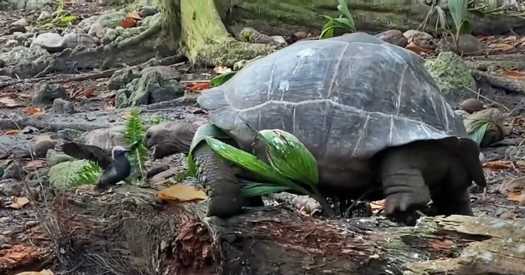It may be time to retire the phrase “gentle giant.”
Researchers in the Seychelles have filmed a giant tortoise hunting and devouring a tern chick in a single gulp. The scientists involved in the discovery say it is the first time such an act has been caught on camera. Even they are shaken up.
“It’s totally surprising and rather horrifying,” said Justin Gerlach, an island ecologist at Peterhouse, Cambridge in England. “The tortoise is deliberately pursuing this bird and kills it, and then eats it. So yeah, it’s hunting.”
Giant tortoises, now found only in the Seychelles and the Galápagos Islands, were believed to be herbivorous. In fact, their vegetarian diets are thought to have shaped their ecosystems, similar to elephants or bison. But in a paper published on Monday in the journal Current Biology, Dr. Gerlach and Anna Zora, a co-author at the Frégate Island Foundation, explain that there have been hints that the hefty reptiles may supplement their diets now and then. Tortoises sometimes consume snail shells and bones from dead birds, goats and even other tortoises. But hunting?
There had been rumors of tortoises stalking seabird chicks, which become helpless after they’ve fallen out of their nests. But until the video was captured — revealing a scene that’s a bit like P.D. Eastman’s “Are You My Mother?” if it had instead been written by Roald Dahl — Dr. Gerlach presumed any such observation was a misunderstanding at best.
“No one’s looked for it, because why would you? Tortoises don’t hunt,” Dr. Gerlach said. “You’re not going to just waste your time looking for a hunting tortoise.”
Now he wonders what else we can learn from these creatures, which can live more than 200 years and grow to more than 500 pounds.
“It’s quite a mystery that they have uncovered here,” said James Gibbs, a herpetologist at the State University of New York and the Galápagos Conservancy who was not involved in the research.
When Dr. Gibbs watched the video, he was surprised at how slowly and awkwardly the attack unfolds.
“It’s a very interesting combination of diligence and incompetence,” he said.
Dr. Gibbs has studied the giant tortoises for about 30 years in the Galápagos, where he said tortoises have developed a curious relationship with birds.
“The tortoises will rise up and extend all their limbs and tail, and finches will come and groom them of ticks,” Dr. Gibbs said. “I’ve heard over the years that sometimes the tortoises will drop down and flatten the finches and eat them. But those were just anecdotes, and having spent many, many years there, I’ve never seen it myself.”
But there’s no mistaking what is happening in the video from the Seychelles. Indeed, the scientists note that the tortoise shows signs of having hunted seabird chicks before.
For instance, when tortoises eat leaves, grass or fruit, they extend their tongues and draw the food into their mouths. But the tortoise in the video has its tongue retracted and its eyes closed — signs that it’s wary of a certain amount of danger with this food source.
“It’s behaving in a different way from normal feeding,” Dr. Gerlach said. “It’s not simply collecting food. It’s killing to collect food.”
According to Dr. Gibbs, that the giant tortoise is female may be an important clue to the shocking behavior. Island systems tend to lack calcium, a critical mineral for building eggshells.
So while the video of a giant tortoise attacking a helpless tern chick may be hard for some people to watch, the act of predation could simply be one way the animals ensure the success of the next generation.
“We’re used to thinking of them as being not particularly interesting, slow moving, and probably quite stupid,” Dr. Gerlach said of giant tortoises. “But clearly there is so much more to these animals.”
Source: Read Full Article
